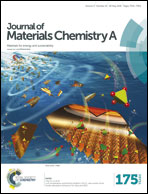Effect of aging and hydrothermal treatment on electrochemical performance of chemically pre-intercalated Na–V–O nanowires for Na-ion batteries†
Abstract
A chemical pre-intercalation approach was used to synthesize Na-containing vanadium oxide nanowires for use as Na-ion battery cathodes. The synthesis method was based on a sol–gel process followed by aging and/or hydrothermal treatment. We have for the first time shown that addition of sodium salt into the hydrothermally treated precursor mixture leads to a higher content of chemically pre-intercalated Na+ ions in the crystal structure of produced layered vanadium oxides. Further, the inclusion of an aging step was found to be crucial for the formation of bilayered NaxV2O5 phase with high capacity in Na-ion cells. Single-phase bilayered NaxV2O5 nanowires, obtained after the hydrothermal treatment of four-day aged precursor, demonstrated a record high initial discharge capacity of 365 mA h g−1. The hydrothermal treatment was shown to improve crystallinity of nanowires, leading to the better electrochemical stability of electrodes. Our results demonstrate the potential of chemical pre-intercalation synthesis method to develop high-capacity Na-ion battery cathodes. The ability to control various parameters in the multi-step chemical pre-intercalation approach opens a door to employing this method for the synthesis of electrode materials for other beyond lithium-ion electrochemical systems, such as Mg-ion and K-ion batteries.


 Please wait while we load your content...
Please wait while we load your content...